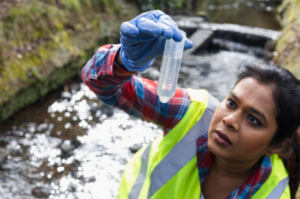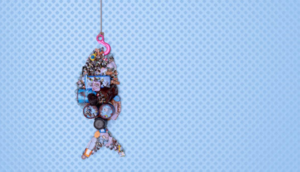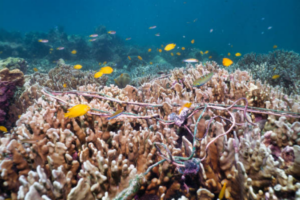The Impact of Microplastics

In the quest for beauty, the modern skincare and cosmetic industry has achieved remarkable innovations, offering an extensive range of products to enhance our appearance and promote healthy skin. However, amidst the allure of radiant skin and luscious hair, a dark and pressing concern looms—the environmental impact of microplastics. These tiny particles, often hidden in our beloved beauty products, pose a significant threat to our oceans, ecosystems, and ultimately, human health. In this comprehensive exploration, we will delve into the insidious world of microplastics, unravel their origins, understand their effects on the environment, and explore sustainable alternatives for a cleaner, greener beauty routine.
Understanding Microplastics
The world of beauty products, often celebrated for its innovation and transformative effects, carries a hidden and insidious threat within its formulations — microplastics. These are minute particles of plastic, typically measuring less than five millimeters, that find their way into an array of personal care items. The insidious nature of microplastics lies not only in their size but also in their capacity to inflict environmental harm, particularly when introduced into aquatic ecosystems.
Types of Microplastics in Beauty Products:
Polyethylene (PE): Often used in exfoliating products like facial scrubs, polyethylene is a common microplastic found in beauty formulations. These tiny beads create the abrasive texture desired for exfoliation but pose a significant threat once they wash down the drain.
Polypropylene (PP): Similar to polyethylene, polypropylene is utilized in exfoliating products and serves the same purpose of providing a scrubbing effect. Both polyethylene and polypropylene are persistent in the environment due to their resistance to degradation.
Nylon: This synthetic polymer is another contributor to the microplastic problem in beauty products. Nylon microbeads are often found in facial scrubs, body washes, and even certain toothpaste formulations.
Polyethylene Terephthalate (PET): Commonly used in glitter found in some cosmetics and personal care items, PET is a microplastic that adds a sparkle to products but raises concerns about environmental impact.
The inadvertent introduction of microplastics into our oceans is a complex journey that begins within the confines of our bathrooms. As we indulge in daily beauty routines, using products designed to cleanse, exfoliate, and enhance our appearance, we often remain blissfully unaware of the environmental impact that accompanies the seemingly harmless act of rinsing off these products.
Microplastics in Personal Care Products:
The inclusion of microplastics in personal care products is deliberate, particularly in items designed for exfoliation and abrasion. Polyethylene and polypropylene beads, along with other types of microplastics, are chosen for their abrasive qualities, providing the desired texture in facial scrubs, body washes, and toothpaste.
Facial Scrubs and Exfoliants:
One of the primary culprits in the introduction of microplastics into water systems is facial scrubs. These products, designed to slough off dead skin cells and promote a smoother complexion, often contain microbeads made of polyethylene or other synthetic materials. As consumers massage these products onto their skin, the tiny beads wash away, destined for the drain.
Toothpaste and Oral Care Products:
Microplastics also find their way into oral care routines. Some toothpaste formulations include microbeads for added abrasiveness, contributing to the overall texture and cleaning action of the product. As we brush our teeth, these microbeads join the journey through the water system.
Rinsing Off and the Wastewater System:
Once these microplastics are introduced into the water system, they face an inadequate fate within wastewater treatment plants. Traditional treatment facilities are not equipped to effectively filter out particles of such minuscule size. As a result, a significant portion of microplastics perseveres through the treatment process, escaping filtration and making their way into bodies of water.
Waterways and Rivers:
From the treatment plants, water containing microplastics is discharged into rivers and waterways. These water bodies act as conduits, transporting the particles downstream, where they accumulate and disperse along the way. The journey of microplastics extends far beyond the point of initial release, influencing diverse ecosystems along its path.
Estuaries and Coastal Areas:
As rivers reach estuaries and coastal regions, the concentration of microplastics may intensify. The proximity to human activity, including urban centers and industrial zones, can exacerbate the problem, contributing to the accumulation of these particles in these critical habitats.
Ocean Infiltration:
Ultimately, the journey of microplastics reaches its culmination as water bodies flow into the vast expanse of the world’s oceans. The introduction of microplastics into marine environments is a global concern, with each water body contributing to the overall burden on the oceans. Once in the open sea, these particles disperse widely, impacting marine ecosystems across the globe.
Global Transport:
Microplastics are not confined to the region of their release; they are capable of global transport through ocean currents. This ability to traverse vast distances makes microplastic pollution a pervasive and interconnected issue, with particles from one region affecting ecosystems far from their source.
Accumulation in Sediments:
As microplastics reach the ocean floor, they can accumulate in sediments. The long-term consequences of this accumulation are still being studied, but it raises concerns about the potential impact on benthic organisms and the overall health of marine ecosystems.

Impact on Marine Life and Ecosystems
The consequences of microplastics in the oceans are far-reaching and devastating. Marine life, from the tiniest plankton to the largest whales, can ingest these particles, mistaking them for food. The ingestion of microplastics can lead to a myriad of health issues, including internal injuries, malnutrition, and bioaccumulation of toxic substances. As smaller organisms consume microplastics, they enter the food chain, affecting larger predators and, eventually, humans who consume seafood.
Beyond ingestion, microplastics also have the potential to transport harmful chemicals and pathogens. These pollutants can adhere to the surface of the particles, creating a toxic cocktail that poses further threats to marine ecosystems. Coral reefs, in particular, are vulnerable, as microplastics can exacerbate existing stressors and contribute to the decline of these vital habitats.
The environmental impact of microplastics extends beyond marine life, reaching humans through the food chain and beyond. As microplastics make their way into seafood, the potential health risks for those who rely on a diet rich in marine products become increasingly concerning. Research is ongoing to understand the implications of consuming microplastics, with potential links to inflammation, immune system suppression, and the introduction of harmful chemicals into the human body.

Regulatory Response
Recognizing the severity of the issue, governments and environmental agencies around the world are taking steps to regulate and reduce the use of microplastics in consumer products. Some countries have implemented bans on certain types of microplastics, while others are actively working to establish guidelines for the cosmetic and personal care industry. Additionally, there is growing pressure on manufacturers to adopt sustainable practices and find alternatives to microplastics in their formulations.
As consumers, we play a pivotal role in steering the beauty industry towards sustainability. By making conscious choices and supporting brands committed to eco-friendly practices, we can contribute to the reduction of microplastic pollution. Here are some tips for embracing a more sustainable beauty routine:
1. Read Labels and Choose Wisely:
Be vigilant about reading product labels. Avoid products containing ingredients such as polyethylene, polypropylene, or nylon, which are indicative of microplastics. Opt for products with natural exfoliants like sugar, salt, or bamboo.
2. Explore Plastic-Free Packaging:
Look for brands that prioritize plastic-free or minimal packaging. From shampoo bars to refillable containers, innovative alternatives are emerging to reduce the beauty industry’s reliance on single-use plastic.
3. Support Sustainable Brands:
Many beauty brands are committing to sustainable practices, including the exclusion of microplastics from their formulations. Support these brands that are dedicated to minimizing their environmental impact.
4. DIY Beauty:
Consider creating your own beauty products using simple, natural ingredients. DIY scrubs and masks allow you to control the ingredients and reduce reliance on commercially manufactured products.
5. Spread Awareness:
Educate others about the environmental impact of microplastics. Share information on social media, engage in discussions, and encourage friends and family to make eco-conscious choices in their beauty routines.

The beauty industry holds immense power to shape consumer habits and influence environmental practices. As awareness grows and demand for sustainable beauty products increases, brands are responding with innovative solutions. Biodegradable alternatives to microplastics, such as plant-based exfoliants and natural abrasives, are gaining popularity.
In addition to ingredient innovations, the concept of circular beauty is emerging. This approach focuses on reducing waste by designing products with a lifecycle that considers the entire product journey, from sourcing to disposal. Brands are exploring ways to implement recycling programs, use recycled materials in packaging, and create products that leave a minimal ecological footprint.
The impact of microplastics on our oceans is a call to action for both the beauty industry and consumers. By understanding the lifecycle of these tiny particles and making informed choices in our beauty routines, we can collectively contribute to a cleaner, healthier planet. From supporting sustainable brands to advocating for stronger regulations, our actions have the power to shape the future of beauty towards a more eco-friendly and responsible industry.
As we navigate the intricate relationship between beauty and the environment, let us embrace a mindset that prioritizes the well-being of our planet. The beauty we seek should not come at the cost of environmental degradation. Together, through conscious choices and a commitment to change, we can redefine beauty standards and create a world where both our skin and our oceans thrive in harmony.




